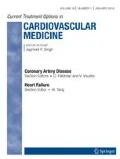Opinion statement
|
-
To date, there are no evidence-based data to support specific drug therapy for a patient with atheroembolism. It makes sense to use HMG CoA (3-hydroxy-3-methylglutaryl coenzyme A) reductase inhibitors (statins) in any patient with atherosclerosis, as these drugs have been shown to reduce the risk of myocardial infarction and stroke, and have a theoretical benefit on plaque stabilization. Surgical treatment should be considered for patients with abdominal aortic or popliteal artery aneurysms and downstream atheroembolism. There are case reports of atheroemboli in patients worsening after given warfarin or heparin. For this reason, some institutions are reluctant to prescribe these drugs for patients with atheroemboli or thromboemboli from aortic plaque. However, the incidence of this complication is quite low. Anticoagulation probably should be stopped if a patient develops atheroembolism.
-
Similarly, the current state of knowledge does not allow for selecting specific pharmacologic intervention in patients with thromboemboli from aortic plaque. Statin therapy does make sense, as these drugs theoretically stabilize plaques and prevent plaque hemorrhage, thrombosis, and subsequent embolization. Unstable aortic plaques may develop superimposed thrombi (red thrombi on pathologic examination), easily seen as mobile elements on transesophageal echocardio-graphy. Therefore, it is possible that anticoagulation with warfarin might prevent embolic events in these patients. For this reason, we are often in the position of recommending warfarin therapy for patients with emboli and severe atheromas seen on transesophageal echocardiography, especially when superimposed mobile thrombi are seen. There are small series in the literature that indicate the potential benefit of warfarin. However, until a large multicenter randomized clinical trial is done, the use of warfarin can not be definitively recommended. Antiplatelet agents, although safer than warfarin (less risk of hemorrhage), have not been proven beneficial in patients with thromboembolism from the aorta. Surgery (endarterectomy) of the aortic arch is a very risky procedure that should not be performed routinely, but may be used in highly selected patients.
Similar content being viewed by others
References and Recommended Reading
Fine MJ, Kapoor W, Falanga V: Cholesterol crystal embolization: a review of 221 cases in the English literature. Angiology 1987, 38:769–784.
Tunick PA, Perez JL, Kronzon I: Protruding atheromas in the thoracic aorta and systemic embolization. Ann Intern Med 1991, 115:423–427.
Applebaum RM, Kronzon I: Evaluation and management of cholesterol embolization and the blue toe syndrome. Curr Opin Cardiol 1996, 11:533–542.
Baumann DS, McGRaw D, Rubin BG, et al.: An institutional experience with arterial atheroembolism. Ann Vasc Surg 1994, 8:258–265.
Case records of the Massachusetts General Hospital. Case 24-1998. A 76-year-old woman with cardiac and renal failure and gastrointestinal bleeding. N Engl J Med 1998, 339:327-339. This is an excellent case discussion and list of references concerning a patient with intestinal atheroembolism and blue toes.
Kvilekval KH, Yunis JP, Mason RA, Giron F: After the blue toe: prognosis of noncardiac arterial embolization in the lower extremities. J Vasc Surg 1993, 17:328–334.
Tunick PA, Kronzon I: Atheromas of the thoracic aorta: clinical and therapeutic update. J Am Coll Cardiol 2000, 35:545–554. This is a review of current knowledge concerning patients with embolic risk from aortic atherosclerosis.
Amarenco P, Cohen A, Tzourio C, et al.: Atherosclerotic disease of the aortic arch and the risk of ischemic stroke. N Engl J Med 1994, 331:1474–1479.
Jones EF, Kalman JM, Calafiore P, et al.: Proximal aortic atheroma: an independent risk factor for cerebral ischemia. Stroke 1995, 26:218–224.
Tunick PA, Rosenzweig BP, Katz ES, et al.: High risk for vascular events in patients with protruding aortic atheromas: a prospective study. J Am Coll Cardiol 1994, 23:1085–1090.
Atherosclerotic disease of the aortic arch as a risk factor for recurrent ischemic stroke. The French Study of Aortic Plaques in Stroke Group. N Engl J Med 1996, 334:1216-1221.
Transesophageal echocardiography correlates of thromboembolism in high-risk patients with nonvalvular atrial fibrillation. The Stroke Prevention in Atrial Fibrillation Investigators Committee on Echocardiography. Ann Intern Med 1998, 128:639-647. This study looked at patients in the Stroke Prevention in Atrial Fibrillation trial who had significant aortic plaque on transesophageal echocardiography. The patients with plaque had a much higher risk of stroke (12%) than the “high-risk” atrial fibrillation patients without plaque (only 1%). It is therefore likely that the aorta may be the source of stroke in some patients with atrial fibrillation. However, although warfarin reduced stroke risk in atrial fibrillation patients with significant aortic plaque, the numbers were small and the study was not randomized to treat aortic plaque.
Ferrari E, Vidal R, Chevallier T, Baudouy M: Atherosclerosis of the thoracic aorta and aortic debris as a marker of poor prognosis: benefit of oral anticoagulants. J Am Coll Cardiol 1999, 33:1317–1322.
Stern A, Tunick PA, Culliford AT, et al.: Protruding aortic arch atheromas: risk of stroke during heart surgery with and without aortic arch endarterectomy. Am Heart J 1999, 138:746–752.
Author information
Authors and Affiliations
Rights and permissions
About this article
Cite this article
Tunick, P.A., Kronzon, I. Embolism from the aorta: Atheroemboli and thromboemboli. Curr Treat Options Cardio Med 3, 181–185 (2001). https://doi.org/10.1007/s11936-001-0036-3
Issue Date:
DOI: https://doi.org/10.1007/s11936-001-0036-3




